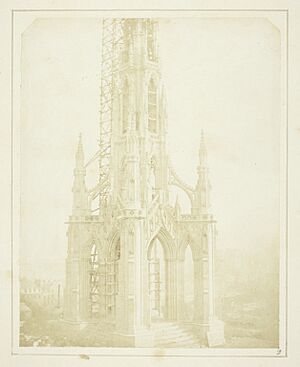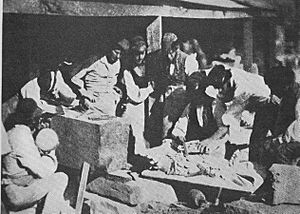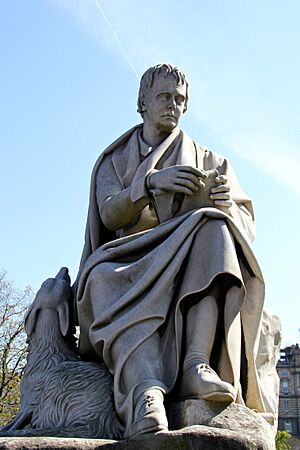Scott Monument facts for kids
The Scott Monument is a huge Victorian Gothic monument built to honor the famous Scottish writer, Sir Walter Scott. It's the second largest monument in the world dedicated to a writer, right after the one for José Martí in Havana. You can find it in Princes Street Gardens in Edinburgh, close to Edinburgh Waverley Railway Station. This station is even named after Scott's popular "Waverley" novels!
Contents
What is the Scott Monument?
A Tower with Amazing Views
The monument is a tall tower, about 61 meters (200 feet) high. It has several viewing platforms that you can reach by climbing spiral staircases. From these platforms, you get incredible views of central Edinburgh and the areas around it. To reach the very top platform, you need to climb 287 steps!
The monument is built from a type of stone called Binny sandstone. This stone was dug up from a quarry near Ecclesmachan in West Lothian.
Where It Stands
The monument is placed in a special spot that makes it a main focus when you look down South St. David Street. It's so big that it helps to frame the view of Edinburgh's Old Town behind it. From other angles, like from the Princes Street Gardens, it might look like it's placed randomly. However, its size and high position make it stand out in the eastern part of the gardens.
How the Monument Was Built
Finding a Design
After Sir Walter Scott passed away in 1832, a competition was held to find the best design for a monument to him. A person named "John Morvo" entered the competition. This was actually a secret name used by George Meikle Kemp, who was a 45-year-old joiner and architect who taught himself. He was worried that people wouldn't pick his design because he didn't have official architectural degrees. But his design was very popular with the judges, and he won the contract in 1838.
The Statue of Sir Walter Scott
Inside the monument, there's a large statue of Sir Walter Scott. It was designed by John Steell. The statue is made from white Carrara marble. It shows Scott sitting down, taking a break from writing with his quill pen. His loyal dog, Maida, is right by his side.
Figures from Scott's Stories
The monument is covered with 64 figures of characters from Scott's famous novels. These statues were created by many Scottish sculptors. Some of these artists include Alexander Handyside Ritchie, John Rhind, William Birnie Rhind, William Brodie, and Amelia Robertson Hill.
Building the Monument
The first stone of the monument was laid on August 15, 1840. Construction started in 1841 and took almost four years to finish. It was completed in the autumn of 1844. George Meikle Kemp's son placed the very top part of the monument in August of that year. The whole project cost a bit more than £16,154.
The monument was officially opened on August 15, 1846. Sadly, George Meikle Kemp wasn't there to see it. He had accidentally fallen into the Union Canal and drowned on a foggy evening in March 1844, while walking home from the building site.
Statues and Figures on the Monument
The Scott Monument is truly a work of art, featuring 68 statues in total. This count doesn't even include the main statue of Sir Walter Scott and his dog! Most of these statues, 64 of them, can be seen from the ground. Four figures are placed very high up, above the final viewing gallery, so they are harder to spot. There are also eight kneeling Druid figures that help support the top viewing gallery.
Famous Scottish Figures
On the lower parts of the monument, you can see 16 heads of famous Scottish poets and writers. These include well-known names like Robert Burns, Lord Byron, and even Mary, Queen of Scots and King James I.
Characters from Novels
The monument is also filled with many characters from Sir Walter Scott's novels. These statues are placed all around the monument, bringing his stories to life in stone. For example, you can find characters from "The Heart of Midlothian" like Jeanie Deans, and figures from "Waverley" such as Flora MacIvor. Other popular characters include Rob Roy MacGregor from "Rob Roy" and figures from "Ivanhoe" like Rebecca and Richard the Lionheart. Each statue tells a small part of Scott's amazing literary world.
Keeping the Monument Beautiful
In the early 1990s, people thought about cleaning the monument's stonework. After some scientific studies, it was decided not to clean it because it might damage the stone. Instead, a big restoration project began. This involved replacing old repairs and damaged areas with new Binny stone, even reopening the original quarry to get the right material! You can see the difference between the new, lighter stone and the older, smoke-darkened parts.
This restoration cost about £2.36 million. It was paid for by the Heritage Lottery Fund, Historic Scotland, and the City of Edinburgh Council.
Today, the monument is managed by the City of Edinburgh Council. In 2016, they put in a new LED lighting system. These lights are designed to make the monument's beautiful features stand out with a soft, warm glow, and they were first turned on in September 2016.
Images for kids
See also
 In Spanish: Monumento a Walter Scott en Edimburgo para niños
In Spanish: Monumento a Walter Scott en Edimburgo para niños






